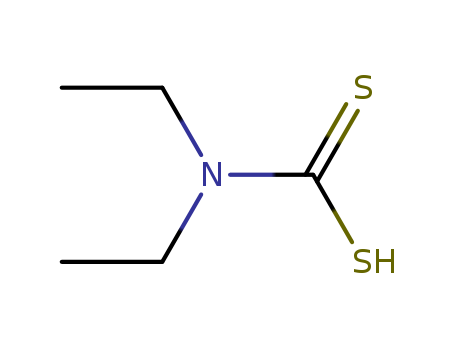- Chemical Name:Diethyldithiocarbamic acid
- CAS No.:147-84-2
- Deprecated CAS:17156-83-1,942650-37-5,942650-37-5
- Molecular Formula:C5H11 N S2
- Molecular Weight:149.281
- Hs Code.:2930909090
- European Community (EC) Number:205-701-7
- UNII:99Z2744345
- DSSTox Substance ID:DTXSID3045017
- Nikkaji Number:J5.841F
- Wikidata:Q27093504
- NCI Thesaurus Code:C432
- Pharos Ligand ID:RJUMF7YA7H38
- Metabolomics Workbench ID:147100
- ChEMBL ID:CHEMBL961
- Mol file:147-84-2.mol
Synonyms:Ammonium Salt Ditiocarb;Bismuth Salt Ditiocarb;Diethylcarbamodithioic Acid;Diethyldithiocarbamate;Diethyldithiocarbamate, Sodium;Diethyldithiocarbamate, Zinc;Diethyldithiocarbamic Acid;Dithiocarb;Ditiocarb;Ditiocarb Sodium;Ditiocarb, Ammonium Salt;Ditiocarb, Bismuth Salt;Ditiocarb, Lead Salt;Ditiocarb, Potassium Salt;Ditiocarb, Sodium Salt;Ditiocarb, Sodium Salt, Trihydrate;Ditiocarb, Tin(4+) Salt;Ditiocarb, Zinc Salt;Imuthiol;Lead Salt Ditiocarb;Potassium Salt Ditiocarb;Sodium Diethyldithiocarbamate;Sodium Salt Ditiocarb;Sodium, Ditiocarb;Thiocarb;Zinc Diethyldithiocarbamate;Zinc Salt Ditiocarb





